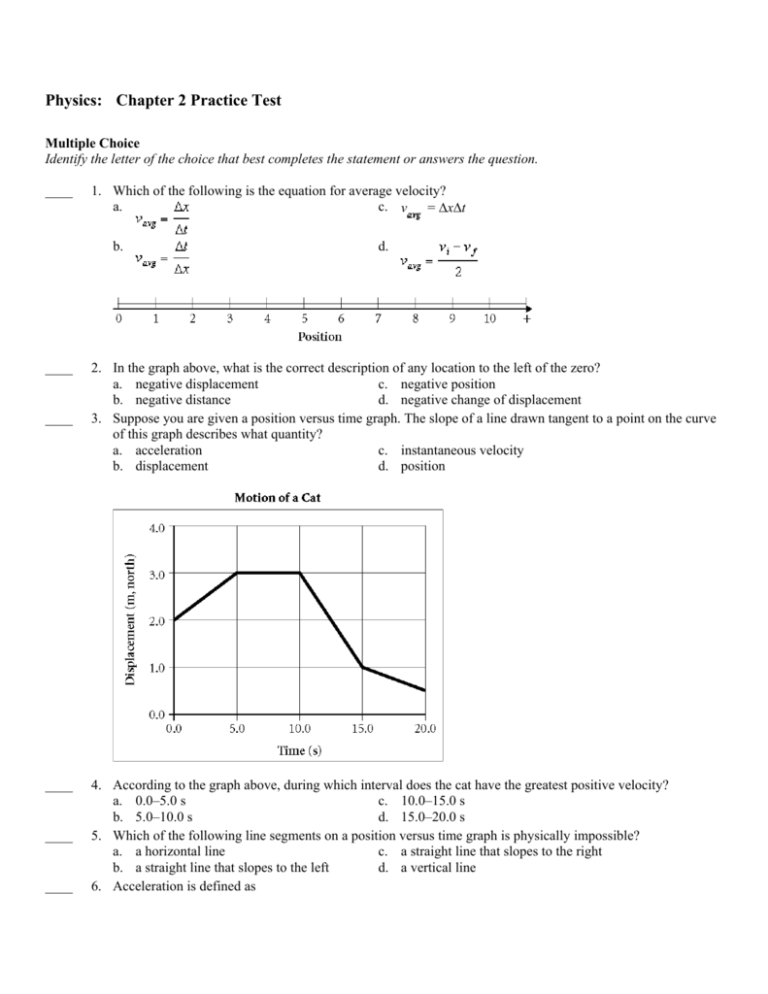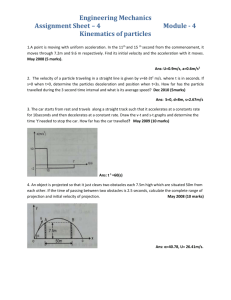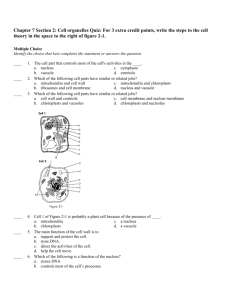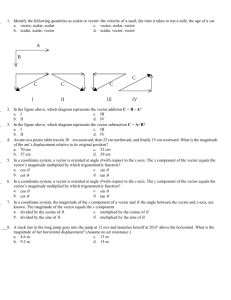Physics: Chapter 2 Practice Test
advertisement

Physics: Chapter 2 Practice Test Multiple Choice Identify the letter of the choice that best completes the statement or answers the question. ____ 1. Which of the following is the equation for average velocity? a. c. v = ΔxΔt b. ____ ____ ____ ____ ____ d. 2. In the graph above, what is the correct description of any location to the left of the zero? a. negative displacement c. negative position b. negative distance d. negative change of displacement 3. Suppose you are given a position versus time graph. The slope of a line drawn tangent to a point on the curve of this graph describes what quantity? a. acceleration c. instantaneous velocity b. displacement d. position 4. According to the graph above, during which interval does the cat have the greatest positive velocity? a. 0.0–5.0 s c. 10.0–15.0 s b. 5.0–10.0 s d. 15.0–20.0 s 5. Which of the following line segments on a position versus time graph is physically impossible? a. a horizontal line c. a straight line that slopes to the right b. a straight line that slopes to the left d. a vertical line 6. Acceleration is defined as ____ a. a rate of displacement. c. the change in velocity. b. the rate of change of displacement. d. the rate of change of velocity. 7. Which of the following is the equation for acceleration? c. a = ΔvΔt a. b. d. ____ 8. When a car’s velocity is positive and its acceleration is negative, what is happening to the car’s motion? a. The car slows down. c. The car travels at constant speed. b. The car speeds up. d. The car remains at rest. ____ 9. The graph above describes the motion of a cyclist. During the interval shown, the cyclist is a. slowing down. c. traveling at the same speed. b. speeding up. d. at rest. ____ 10. What does the graph above illustrate about acceleration? a. The acceleration varies. b. The acceleration is zero. c. The acceleration is constant. d. The acceleration increases then becomes constant. ____ 11. The graph above describes the motion of a ball. At what point is the velocity of the ball equal to its velocity at B? a. A c. D b. C d. none of the above ____ 12. The motion of a ball on an inclined plane is described by the equation quantities must have a value of zero? a. x b. x c. v d. t . Which of the following ____ 13. A baseball catcher throws a ball vertically upward and catches it in the same spot as it returns to the mitt. At what point in the ball’s path does it experience zero velocity and nonzero acceleration at the same time? a. midway on the way up b. at the top of its path c. the instant it leaves the catcher’s hand d. the instant before it arrives in the catcher’s mitt ____ 14. When there is no air resistance, objects of different masses dropped from rest a. fall with equal accelerations and with equal displacements. b. fall with different accelerations and with different displacements. c. fall with equal accelerations and with different displacements. d. fall with different accelerations and with equal displacements. ____ 15. Which would fall with greater acceleration in a vacuum—a leaf or a stone? a. the leaf b. the stone c. They would accelerate at the same rate. d. It is difficult to determine without more information. Short Answer 16. If a cat moves from a negative position to a positive position, is the cat’s displacement negative or positive? Explain. 17. If a runner moves from a positive position to a negative position, is the runner’s displacement negative or positive? Explain. 18. Construct a graph of position versus time for the motion of a dog, using the data in the table above. What is the dog’s average velocity? 19. Two rocks are dropped simultaneously and undergo free fall. Compare their displacements after equal intervals of time. Problem 20. The graph above shows displacement versus time. What is the average velocity for line A? 21. A toy car is given an initial velocity of 5.0 m/s and experiences a constant acceleration of 2.0 m/s . What is the final velocity after 6.0 s? 22. A soccer ball is moving horizontally at a speed of 3.0 m/s. It then undergoes a constant negative acceleration. After 4.0 s, the ball is moving at 1.5 m/s. What is the ball’s displacement? 23. A race car accelerates from 0.0 m/s to 30.0 m/s with a displacement of 45.0 m. What is the car’s acceleration? 24. Human reaction time is usually about 0.20 s. If your lab partner holds a ruler between your finger and thumb and releases it from rest without warning, how far can you expect the ruler to fall before you catch it? (Disregard air resistance. a = −g = −9.81 m/s .) 25. A coin released at rest from the top of a tower hits the ground after falling 1.5 s. What is the speed of the coin as it hits the ground? (Disregard air resistance. a = −g = −9.81 m/s .) Physics: Chapter 2 Practice Test Answer Section MULTIPLE CHOICE 1. 2. 3. 4. 5. 6. 7. 8. 9. 10. 11. 12. 13. 14. 15. ANS: ANS: ANS: ANS: ANS: ANS: ANS: ANS: ANS: ANS: ANS: ANS: ANS: ANS: ANS: A C C A D D B A B A D C B A C DIF: DIF: DIF: DIF: DIF: DIF: DIF: DIF: DIF: DIF: DIF: DIF: DIF: DIF: DIF: I I I II II I I II I I II I II I I OBJ: OBJ: OBJ: OBJ: OBJ: OBJ: OBJ: OBJ: OBJ: OBJ: OBJ: OBJ: OBJ: OBJ: OBJ: 2-1.1 2-1.1 2-1.3 2-1.3 2-1.3 2-2.1 2-2.1 2-2.1 2-2.2 2-2.2 2-2.2 2-2.3 2-3.1 2-3.3 2-3.3 SHORT ANSWER 16. ANS: The displacement is positive because a change of position in the direction of increasing positive position is positive displacement. DIF: II OBJ: 2-1.1 17. ANS: The displacement is negative because a change of position in the direction opposite of increasing positive position is negative displacement. DIF: II 18. ANS: +0.50 m/s OBJ: 2-1.1 Given x = 0.5 m x = 3.0 m t = 1.0 s t = 6.0 s Solution DIF: I OBJ: 2-1.3 19. ANS: The displacements are equal. DIF: I PROBLEM 20. ANS: 3.0 m/s Given x = 0.0 m x = 9.0 m t = 0.0 s t = 3.0 s Solution OBJ: 2-3.3 DIF: IIIA 21. ANS: 17 m/s OBJ: 2-1.3 Given v = 5.0 m/s a = 2.0 m/s Δt = 6.0 s Solution DIF: IIIB 22. ANS: 9.0 m OBJ: 2-2.3 Given v = 3.0 m/s v = 1.5 m/s Δt = 4.0 s Solution DIF: IIIB 23. ANS: 10.0 m/s OBJ: 2-2.3 Given v = 0.0 m/s v = 30.0 m/s Δx = 45.0 m Solution DIF: IIIB 24. ANS: at least 0.20 m Given a = −g =−9.81 m/s OBJ: 2-2.3 Δt = 0.20 s v = 0.0 m/s Solution DIF: IIIA 25. ANS: 15 m/s OBJ: 2-3.2 Given a = −g = −9.81 m/s v = 0.0 m/s Δt = 1.5 s Solution speed = 15 m/s DIF: IIIB OBJ: 2-3.2









